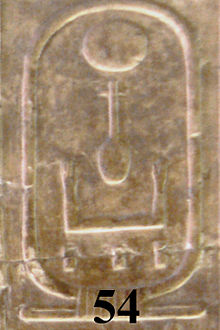Neferkaure
| Neferkaure | ||||||||||||||||||||||||||||||||||||||||||||
|---|---|---|---|---|---|---|---|---|---|---|---|---|---|---|---|---|---|---|---|---|---|---|---|---|---|---|---|---|---|---|---|---|---|---|---|---|---|---|---|---|---|---|---|---|
| Neferkawre, Kha[bau?] | ||||||||||||||||||||||||||||||||||||||||||||
 The cartouche of Neferkaure on theAbydos King List. | ||||||||||||||||||||||||||||||||||||||||||||
| Pharaoh | ||||||||||||||||||||||||||||||||||||||||||||
| Reign | 4 years and 2 months, c. 2160 BC | |||||||||||||||||||||||||||||||||||||||||||
| Predecessor | Qakare Ibi | |||||||||||||||||||||||||||||||||||||||||||
| Successor | Neferkauhor | |||||||||||||||||||||||||||||||||||||||||||
| ||||||||||||||||||||||||||||||||||||||||||||
| Dynasty | Eighth Dynasty | |||||||||||||||||||||||||||||||||||||||||||
Neferkaurewas apharaohof ancient Egypt during theFirst Intermediate Period.According to theAbydos King Listand the latest reconstruction of theTurin canonbyKim Ryholt,he was the 15th king of theEighth Dynasty.[1]This opinion is shared by the EgyptologistsJürgen von Beckerath,Thomas Schneider and Darell Baker.[2][3][4]As a pharaoh of the Eighth Dynasty, Neferkaure's seat of power wasMemphis[5]and he may not have held power over all of Egypt.
Attestations[edit]
Neferkaure is named on the 54th entry of theAbydos King List,a king list redacted some 900 years after theFirst Intermediate Periodduring the reign ofSeti I.Neferkaure's name is lost in a lacuna of theTurin canonaffecting column 5, line 11 of the document. The length of Neferkaure's reign is nonetheless preserved with "4 years, 2 months and 0 days".[1][4][6]
Neferkaure is also known from a contemporary inscription, a fragmentary decree inscribed on a limestone slab known asCoptos Decree hand concerning offerings for the temple ofMinatCoptos.[4]One of the two existing fragments of this decree was given byEdward Harknessto theMetropolitan Museum of Art,where it is now on display in Gallery 103.[7] The decree is dated to the fourth regnal year of Neferkaure, which is the highest attested date of any king of the Eighth Dynasty.[8]The first sign of the king'sHorus nameis clearly present while the second sign is debated. von Beckerath commits only to the first sign and readsKha[...],while Baker andWilliam C. HayesreadKhabau.[2][4][8]The decree is addressed to the then governor ofUpper Egypt,Shemay,and requires that fixed amounts of offerings be given at regular intervals to the god Min and then possibly to a statue of the king.[8]
References[edit]
- ^abKim Ryholt:The Late Old Kingdom in the Turin King-list and the Identity of Nitocris,Zeitschrift für ägyptische, 127, 2000, p. 99
- ^abJürgen von Beckerath:Handbuch der ägyptischen Königsnamen.Deutscher Kunstverlag,München/ Berlin 1984,ISBN3-422-00832-2,p. 59, 187.
- ^Thomas Schneider: Lexikon der Pharaonen. Albatros, Düsseldorf 2002,ISBN3-491-96053-3,p. 174.
- ^abcdDarrell D. Baker: The Encyclopedia of the Pharaohs: Volume I - Predynastic to the Twentieth Dynasty 3300–1069 BC, Stacey International,ISBN978-1-905299-37-9,2008, p. 272-273
- ^Ian Shaw:The Oxford History of Ancient Egypt,ISBN978-0192804587
- ^Jürgen von Beckerath:The Date of the End of the Old Kingdom of Egypt,JNES 21 (1962), p.143
- ^The decree on thecatalog of the MET
- ^abcWilliam C. Hayes:The Scepter of Egypt: A Background for the Study of the Egyptian Antiquities in The Metropolitan Museum of Art. Vol. 1, From the Earliest Times to the End of the Middle Kingdom,MetPublications, 1978, pp.136-138,available online

